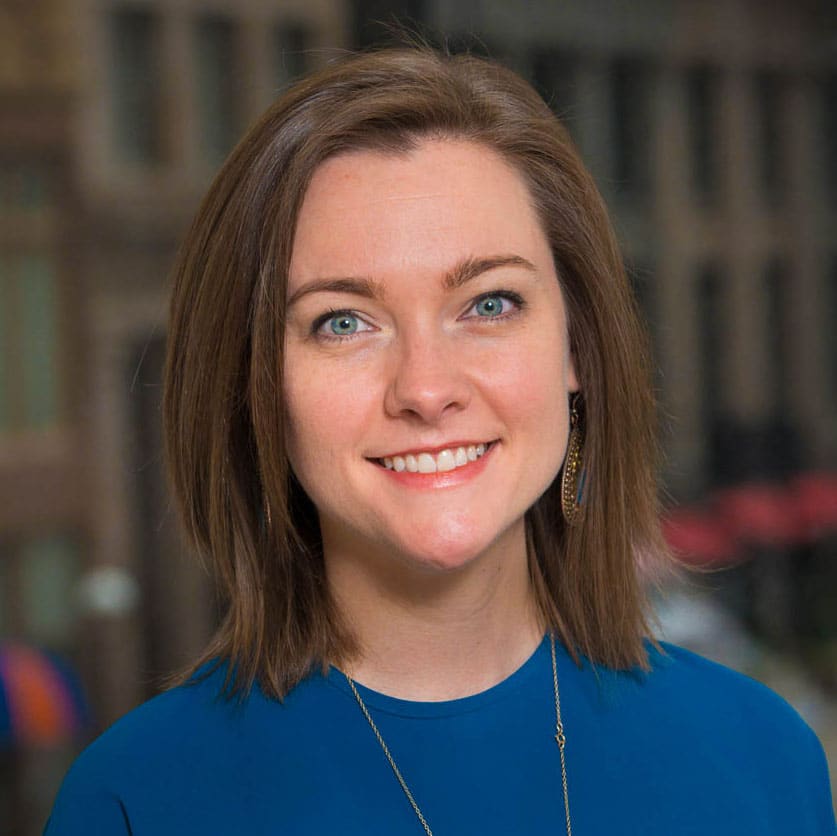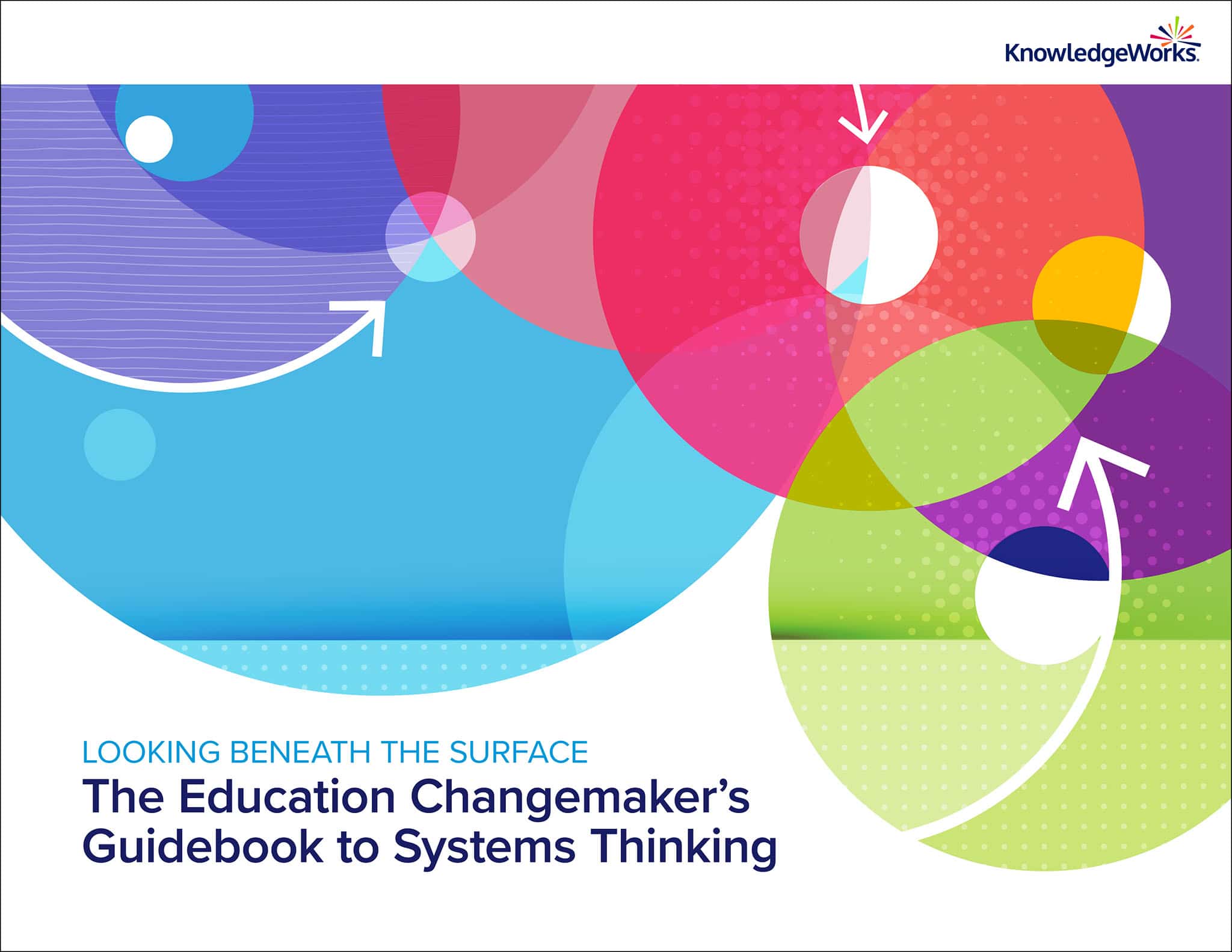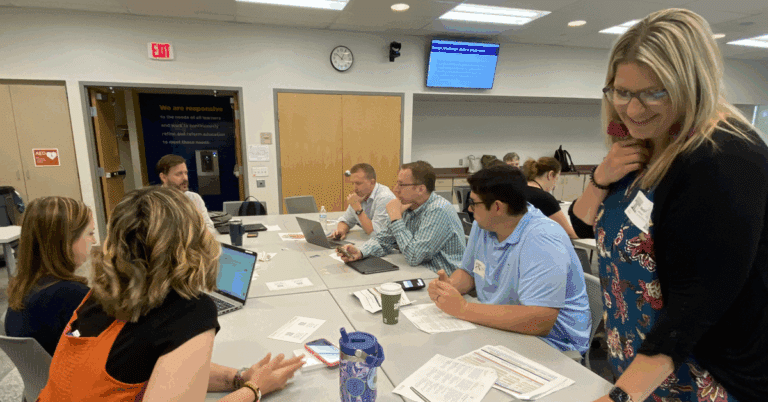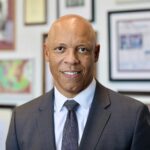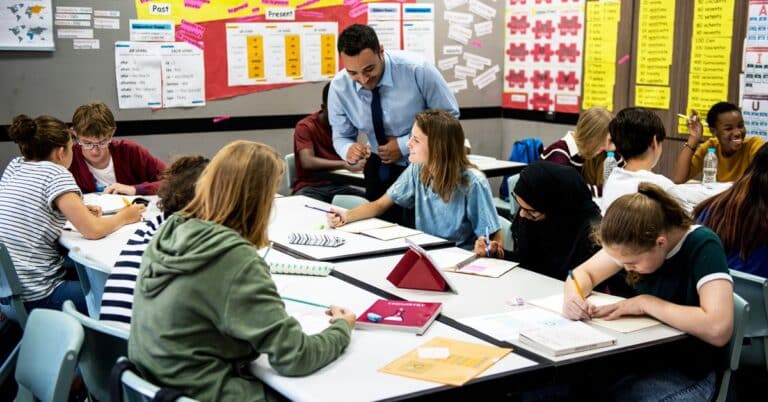Education leaders at the district, state and federal levels have all been grappling with systemic disruptions. How can education leaders navigate disruptions and potential disruptions with systems thinking?
The following conversation between Katie King, director of strategic foresight engagement at KnowledgeWorks, and Andy Withers, superintendent at Grass Valley School District in Grass Valley, California, explores how education leaders can use systems thinking tools to create resilient future-ready districts. Watch or read the transcript below.

King: So KnowledgeWorks published earlier this year a guidebook on systems thinking for educators. And you have a lot of experience and have done some training and some work in your previous roles with systems thinking. We’re trying to help education leaders and changemakers understand how they can incorporate systems thinking into their daily work. I would just love to hear from you: What do you think are the most valuable aspects of systems thinking in your experience, and how do you think they help you in your daily work?
Withers: Yeah. Thank you. I was privileged to be a part of the work of systems thinking for the last four years in a neighboring school district down in the Sacramento County area. Obviously I’m still a learner of systems thinking – I don’t think it’s something you ever master – but I was able to also eventually earn the opportunity to be a systems thinking mentor and coach for others within that school district. What systems thinking has done for me is it really allowed me to be a more thoughtful and reflective leader. There are many habits and tools within systems thinking that I feel like I personalized and made my own, while at the same point, there were additional habits I still am a learner and studying. The biggest value for me has been that it’s just felt natural. It isn’t a buzzword or something to do to impress someone; it’s just how good organizations and individuals go about evaluating their effectiveness and planning for the future. So it’s almost a mindset in many ways.

“What systems thinking has done for me is it really allowed me to be a more thoughtful and reflective leader.”
Systems thinking as a support during COVID-19
King: Great. So this obviously has been a really challenging school year, the end of last year and the beginning of this year, and a lot of systems are overlapping, some of which performing and serving us better than others in these pandemic times. So I wonder if you have any examples or thoughts on how being a systems thinker has helped you and supported you in making decisions and in being a leader in this really challenging time.
Withers: So being a new superintendent, choosing to apply for this wonderful job and position in the middle of a pandemic, you might say, I knew what I was getting into while at the same point, I don’t think anyone knows what they’re getting into in this pandemic. I guess the most easily described aspect of, how have I used systems thinking in this role or, this year is, trying to maintain a sense of calm and logic and long-term focus while at the same point acknowledging very little is within our control. If you know education, you know that we’re on our third framework since this pandemic started as to how we should operate and how we might operate. And we get potentially weekly, significant changes, whether it’s from the California Department of Education or our governor or the department of public health; whether it’s at the state level or the local level. Sometimes the guidance changes in a very big or maybe a perceived small way. And all of those things have an impact on how we safely and appropriately educate students.
One of the ways I’m very fortunate is that, we were one of the last school districts in our county to choose to transition to in-person learning. While some might’ve thought that as a loss, we weren’t ready to launch in-person services in a pandemic in August as some other school districts might have. So we spent time planning, studying, observing, looking around the state and then trying to create what ends up being a fairly simplistic framework at which we run our decisions through. Back before it was maybe as popular as it is now, we developed a three-phase implementation model for the school year with phase one being distance learning, phase two being hybrid and phase three being traditional learning, with obviously additional safety precautions in place.
So while we navigated the start of the school year, our first few months in distance learning, we transitioned on November 2nd to hybrid learning. We’re obviously evaluating the success of that. We evaluated the instructional model of that, and we looked at everything from how long should our day be? How do we offer options for families and students who aren’t ready for in-person services? How do we make sure that our teachers and staff have the tools to teach both in-person and synchronously from both a professional development standpoint to a technology tool standpoint.
As we do our best to work collaboratively, we ended up with, I think, a great solid program across our school district. We have two different models, one in our charter school and one at our non-charter sites. And they both seem to be serving students and staff well and keeping folks safe, while at the same point, we’re always analyzing our practices. How can we get better? How can we be safer? How can we be safest throughout this pandemic as we learn new information?

Looking Beneath the Surface is a guidebook that introduces education stakeholders and changemakers to the theories, language, mindsets and tools of systems thinking for the purpose of informing approaches to systems change.
Read now >
King: Yeah. What I’m hearing there, as far as connecting it to systems thinking, really looking at the interconnections between things and seeing that when we pull on one thread of saying, we’re going to make this decision recognizing that that has ripple effects and consequences, both short- and long-term for the rest of the people in your system and way that the system itself operates. So that seems to be a pretty critical element. We’ve really gotten a very clear view of how connected everything in our society and our education system is, and it sounds like that’s been a big part of the district’s decision making up to this point.
Withers: Absolutely.
Tips on learning systems thinking
King: For folks who are less familiar with systems thinking – maybe they’ve downloaded our guidebook, maybe they’re just getting started, maybe thinking back to your own experience getting started in using these tools and mindsets – do you have any recommendations for people who are wanting to kind of take this learning journey on themselves?
Withers: Yeah. Great question. And that’s one that was framed at me as well as what I framed to other people when I had the opportunity to mentor them in systems thinking. I would simply say: Try to take a big approach and look at what systems thinking is, and then just pick a habit, a tool, and implement it. The two that come to mind would be considering the unintended consequences or avoiding quick fixes, which is kind of related. When I examine those two tools or mindsets, it helps me reflect back on other leadership opportunities when things maybe didn’t go as well, despite my best efforts, and how I might have had a time to pause and reflect before making critical key decisions to ensure it’s the right decision.
Quick fix simply put is, a quick decision I’m making today, right in front of me, that feels right, it is right, it solves that problem, but realizing use the word ripple earlier, there might be other things down the line that quick fix will have an impact on, and maybe a significant negative impact or maybe not. And so before you make that quick fix decision, I’m going to do this, or I’m not going to do this, today or tomorrow, or whatever’s in front of you – it feels imminent often – is give yourself the opportunity to pause and consider the unintended consequence of taking or not taking action.

“Give yourself the opportunity to pause and consider the unintended consequence of taking or not taking action.”
Once I had that mindset trying to share with my team poor quick-fix decisions I’ve made and how, in my opinion, good teams talk about difficult decisions and good teams discuss and maybe even argue or have critical dialogue before a decision is made. Now, sometimes depending on the situation, you don’t have that kind of time, but many times you do. And if you train not only yourself but your team to help you through those times, you often can avoid the quick-fix mentality. It’s like a crash diet versus an analysis of your health. So that would be my recommendation.
King: Yeah. I think one of the most important takeaways and lessons that I have from systems thinking is that we all only have a limited view of any system. And we have to engage in dialogue with people who have a different set of experiences and different perspective on how that system is or isn’t working. So when we’re reflecting on those decisions we’ve made, whether they felt like they went well to us or not, getting those perspectives engaging in that dialogue, really trying to unpack how all of us are seeing and experiencing this system is really critical to that analysis and to the learning journey that you referenced.
Withers: Yeah. To contribute to what you just said, it’s honoring that perception as reality. I thought it was successful and you did not, we are both “right” with our opinion. And when we’re on the same team, we actually want that healthy discourse and dialogue. So I, who maybe thought it was successful, can understand why you don’t think it was. In a perfect world, we would have had clear vision and metrics and clarity on success before we started it, to avoid me thinking it was a success and you thinking it wasn’t. In a perfect world, we would have done that, but sometimes that wasn’t done. And so it’s honoring perception as reality. If I think this tastes good, it tastes good; if you think it doesn’t, it doesn’t. And if we’re in the same team and we’re delivering a product, we want to have clarity of vision of success, so we avoid that issue.
Education is the place to dive in together with futurists’ tools to think about problems and solutions at a deeper, inclusive level to help enact change. Why is now the perfect time to do so?
